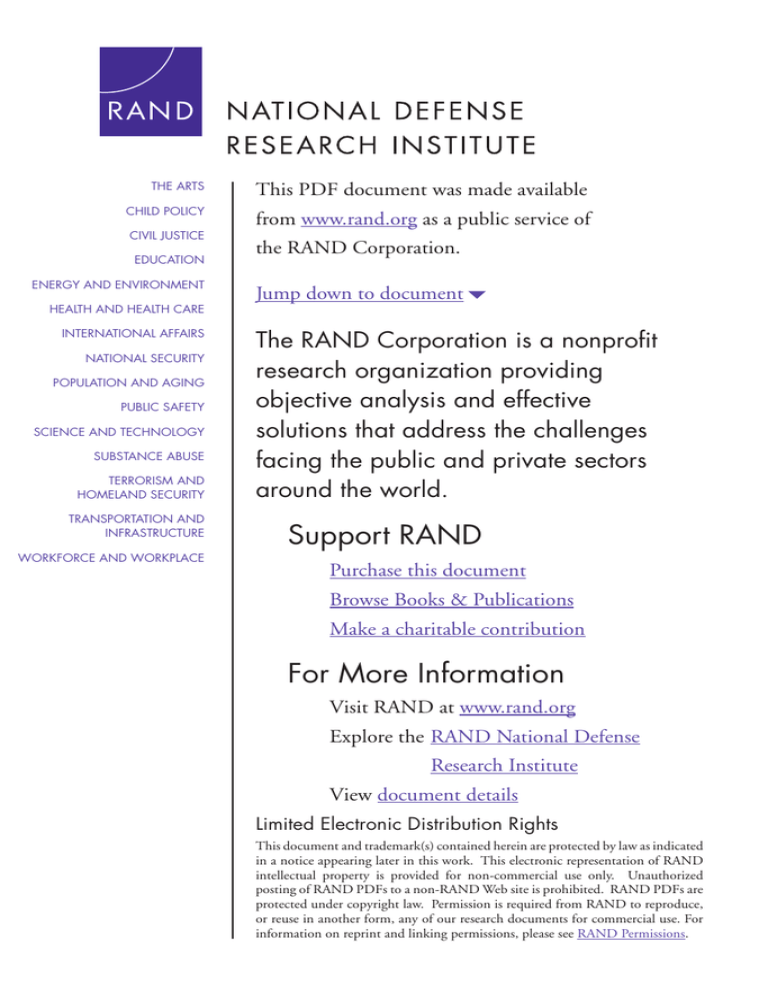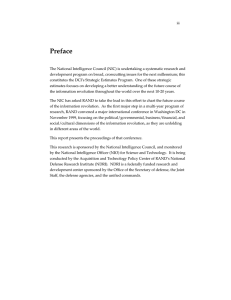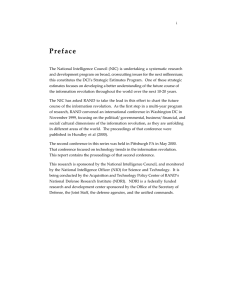6 The RAND Corporation is a nonprofit from
advertisement

THE ARTS This PDF document was made available CHILD POLICY from www.rand.org as a public service of CIVIL JUSTICE EDUCATION ENERGY AND ENVIRONMENT HEALTH AND HEALTH CARE INTERNATIONAL AFFAIRS NATIONAL SECURITY POPULATION AND AGING PUBLIC SAFETY SCIENCE AND TECHNOLOGY SUBSTANCE ABUSE TERRORISM AND HOMELAND SECURITY TRANSPORTATION AND INFRASTRUCTURE WORKFORCE AND WORKPLACE the RAND Corporation. Jump down to document6 The RAND Corporation is a nonprofit research organization providing objective analysis and effective solutions that address the challenges facing the public and private sectors around the world. Support RAND Purchase this document Browse Books & Publications Make a charitable contribution For More Information Visit RAND at www.rand.org Explore theRAND National Defense Research Institute View document details Limited Electronic Distribution Rights This document and trademark(s) contained herein are protected by law as indicated in a notice appearing later in this work. This electronic representation of RAND intellectual property is provided for non-commercial use only. Unauthorized posting of RAND PDFs to a non-RAND Web site is prohibited. RAND PDFs are protected under copyright law. Permission is required from RAND to reproduce, or reuse in another form, any of our research documents for commercial use. For information on reprint and linking permissions, please see RAND Permissions. This product is part of the RAND Corporation monograph series. RAND monographs present major research findings that address the challenges facing the public and private sectors. All RAND monographs undergo rigorous peer review to ensure high standards for research quality and objectivity. Analysis of Strategy and Strategies of Analysis David C. Gompert, Paul K. Davis, Stuart E. Johnson, Duncan Long Prepared for the Joint Staff Approved for public release; distribution unlimited NAT IONA L DEFENS E RES EA RC H INSTITUTE The research described in this report was sponsored by the Joint Staff. The research was conducted in the R A ND National Defense Research Institute, a federally funded research and development center sponsored by the Office of the Secretary of Defense, the Joint Staff, the Unified Combatant Commands, the Department of the Navy, the Marine Corps, the defense agencies, and the defense Intelligence Community under Contract W74V8H-06-C-0002. Library of Congress Cataloging-in-Publication Data Analysis of strategy— strategies of analysis / David C. Gompert ... [et al.]. p. cm. Includes bibliographical references. ISBN 978-0-8330-4503-4 (pbk. : alk. paper) 1. United States—Strategic aspects. 2. Military planning—United States. 3. Strategic planning—United States. 4. National security—United States. 5. Strategy. I. Gompert, David C. UA23.A6658 2008 355'.033573—dc22 2008030919 Cover illustration by ImageZoo courtesy of Media Bakery. The RAND Corporation is a nonprofit research organization providing objective analysis and effective solutions that address the challenges facing the public and private sectors around the world. R AND’s publications do not necessarily reflect the opinions of its research clients and sponsors. R® is a registered trademark. © Copyright 2008 RAND Corporation All rights reserved. No part of this book may be reproduced in any form by any electronic or mechanical means (including photocopying, recording, or information storage and retrieval) without permission in writing from RAND. Published 2008 by the RAND Corporation 1776 Main Street, P.O. Box 2138, Santa Monica, CA 90407-2138 1200 South Hayes Street, Arlington, VA 22202-5050 4570 Fifth Avenue, Suite 600, Pittsburgh, PA 15213-2665 RAND URL: http://www.rand.org To order RAND documents or to obtain additional information, contact Distribution Services: Telephone: (310) 451-7002; Fax: (310) 451-6915; Email: order@rand.org Summary Analyzing alternative national defense strategies and their implications is hard work, especially in unsettled global security conditions. Time may be short, decisionmakers impatient, experience unhelpful, intuition unreliable, and the future unpredictable. Yet failing to analyze strategy before, not after, it is adopted can produce costs, risks, and results for which the Department of Defense (DoD) and the nation are unprepared and which, if understood in the first place, might have argued for a different or reworked strategy. For example, DoD has spent some $0.8 trillion more than originally projected to perform its part in what the current U.S. administration describes as the “global war on terrorism” (GWOT). Although the United States might in any case have opted to take large-scale offensive military action in the Muslim world, a strategy chosen without analysis in the pressurized political atmosphere following the attacks of September 11, 2001, has led to unexpected bills, uneven results, and unwanted side effects. An unstable security environment makes strategic analysis as essential as it is difficult. Yet DoD, for all its analytic prowess, does not afford the consideration of strategy the same disciplined reasoning that goes into routine annual budget-building and acquisition decisionmaking in the execution of strategy. Official strategy statements are more for documenting strategy than analyzing it. Shifts in global security of the sort that may warrant a change in strategy do not conform to the quadrennial rhythm of mandated national defense reviews. This is the context in which the Joint Staff asked RAND to find a way to perform “resource-informed” strategic analysis, of the sort that xi xii Analysis of Strategy and Strategies of Analysis would enable the Chairman of the Joint Chiefs of Staff to advise the Secretary of Defense of the main implications of defense strategy before its adoption. Although the impetus for this study was concern about the costs of national defense strategy—an obvious concern in times of mounting defense costs—the work necessarily addressed as well the expected results and risks of strategy. Each of these major implications of strategy affects the others: Improving expected results may involve increasing likely costs; decreasing costs may mean accepting greater risks; and so forth. Indeed, so interdependent are these three factors that they must be examined together, making strategic analysis that much harder. In tackling this problem, we have explored how other complex enterprises operating in dynamic environments go about analyzing strategic alternatives and implications. In particular, large diversified corporations competing in challenging markets tend to rely on subordinate operating units (or lines of business) not only to carry out strategy but also to provide the prism through which they can assess the likely results, risks, and costs of strategy before embarking on it. Reliance on operating units is not as universal or uniform as business-school teachings suggest, but it is a proven way for corporations to maintain oversight without quashing initiative and to marry strategic direction with market-based responsiveness and opportunism. For all the differences between the corporate and defense worlds, reliance on operating units both to analyze and to execute strategy is a common key idea. Indeed, the same challenge that leads corporations to plan and manage by operating units—to focus diverse capabilities for success in fluid conditions—makes operating units important in the performance and analysis of national defense. As with other complex enterprises operating in turbulent environments, DoD needs visibility into operations without micromanaging them; it needs to shape but not dictate how subordinate line organizations respond to conditions; and it needs to know how to align resources to achieve the operating objectives that flow from national strategy. As the nearest thing to corporate operating units, the unified combatant commands (COCOMs) can serve these purposes. Summary xiii The key to improving strategic analysis is thus to pursue further the logic of jointness by giving greater prominence to COCOMs in linking the goals to the requirements of global strategy. The COCOMs are expected to respond with agility, unity, and focus—despite DoD’s size and complexity—to the demands and opportunities of an unstable security environment. Because they are the chief agents of strategy, their operating objectives should define the need for the capabilities and resources a given strategy requires. As with corporate operating units, COCOMs offer a way to analyze the implications of strategic choice. It has been observed that COCOMs are generally not good at taking a long view—owing to the immediate pressures they face—and so strategy is not their forte. Of course, this is also true of most business operating units, especially with the impatience of Wall Street traders and corporate headquarters to see quarterly results. This is one reason why, in both worlds, responsibility for setting strategy rests with corporate executives (or national leaders), whose horizons are both long-term and market-wide (or global). The potential importance of COCOMs lies not in setting national strategy but in translating it into operating objectives and in turn expressing demand for capabilities to achieve those objectives, thus allowing strategy and resources to be linked. The experience of complex enterprises suggests two other, complementary ideas of significance to strategic analysis. One is portfolio analysis, which is particularly important for a world power with diverse interests and responsibilities. National defense, as with diversified corporations, is best understood as a portfolio, in which multiple goals compete for capabilities and resources—for instance, countering Islamist insurgencies, ensuring access to world energy supplies, coping with increased Chinese power, partnering with allies, and protecting the United States. Just as strategy must address these goals, stressing some without neglecting others, strategic analysis must be portfolio analysis. Because operating units are the chief agents of strategy, they provide a good way to analyze the portfolio that is national defense. The third idea is to develop what we call “inside-out” strategy, which is the exploitation of the enduring strengths of an enterprise— often referred to as “core competencies” in the business realm—in xiv Analysis of Strategy and Strategies of Analysis meeting external demands and opportunities. In national defense, harnessing the basic qualities of the country itself—inventiveness, market freedom, scale, and geographic advantages—can offer an especially potent and economical way to meet external demands and opportunities. All else being equal, the integration of inside-out strategy with “outside-in” (externally determined) strategy can help produce desired results at affordable costs with manageable risks. It follows that the awareness of core strengths and how they can be embodied in defense capabilities is a crucial aspect of strategic analysis and of strategy itself. Drawing on what we believe are sound methods of strategic analysis for complex enterprises operating in unstable environments, we offer the following approach to DoD strategic analysis: a. b. c. d. e. f. g. Express global strategic goals in the current environment. From these goals, derive specific objectives for each operating unit. Identify capabilities that operating units need to achieve these objectives. Specify the forces and support needed to deliver these capabilities. Using portfolio analysis, assess the costs of preparing, deploying, and employing these forces and support, along with expected results and risks. Do likewise for alternative strategies of interest to permit comparison. Iterate to improve strategy in light of implications and core strengths. DoD has ample analytic capability and experience for each link in this chain of reasoning: The innovation lies in the chain, not the individual links. Of special importance in associating strategy with resources—the Joint Staff’s original query—is the ability to identify the capabilities needed to enable operating units to meet their objectives pursuant to strategy. In this regard, the “component commands”— i.e., for ground, naval, and air forces—that couple the COCOMs with Summary xv the military services are critical to connecting the needs and means of strategy. As noted, organizing strategic analysis around COCOMs is a natural next step in advancing jointness. At the same time, the military services are crucial to strategy because they provide most of the capabilities needed to meet operating objectives: forces, equipment, support, doctrine, and skills. More than that, they are the repository of deep, lasting knowledge and competence, as well as the source of most innovations in capabilities based on their interpretation of global needs. In this sense, they are also the adaptors and conveyors of those core national strengths that can produce better results economically. A central point is that the COCOMs and the military services—the demanders and providers of capabilities—can and should form a natural partnership that links global strategy to core strengths. Finally, just as the top managers of any complex enterprise must outline strategy and nurture the partnership of operators and capability providers, so must DoD’s civilian leaders and the Joint Chiefs of Staff. Thus, for all their differences, the Defense Department and typical large diverse corporations are architectural kin. Applying these ideas in the study on which this report is based, we offer a framework for strategic analysis with three dimensions: t operating units (COCOMs) that constitute the portfolio of national defense t alternative strategies that distribute weight, and thus capabilities and resources, differently across this portfolio t assessment and comparison of implications—expected results, risks, and costs—of each portfolio strategy. Using this framework, our companion report offers first-order assessments of the implications, by COCOM, of three illustrative strategies, each with a different primary emphasis: countering Islamic insurgency directly with U.S. forces; building up effective local partners to bear more of the burden of security; and responding to rising Chinese power and assertiveness. Although only illustrative, the results indicate significant differences among the alternatives in the composi- xvi Analysis of Strategy and Strategies of Analysis tion and assignment of military capabilities, likely effectiveness, risks, and costs. The same framework also invites “exploratory analysis” that permits leaders to see how tailoring strategy affects expected results, risks, and costs. The formulation of national defense strategy is best accomplished through iterative reasoning, whereby the objectives may be rethought and revised in the light of their implications. For any complex enterprise, analyzing and setting strategy based on external demands and opportunities, although essential, may be insufficient to deliver success. Leading corporations integrate the needs of their operating units with a clear sense of their core competencies and how to apply them. For example, Toyota’s strategic goal is to achieve the leading market share globally. Because this requires that it compete aggressively in the U.S. market, it aligns its marketing objectives and investments accordingly. Simultaneously, Toyota understands that its ability to make consistently reliable cars on a large scale—its core strength—is the key to taking U.S. market share, which in turn enlarges production. Such holistic thinking can also be found in the annals of the strategy of nations. Great Britain’s 18th- and 19th-century strategy of using its maritime superiority to acquire choice colonies, thus expanding its resource base and power, permitted Pax Britannia and guaranteed national security and prosperity. Today, China’s effort to extend its reach and clout globally is motivated by the need to assure access to the markets and inputs it needs to sustain strong economic growth, which provides it with the wherewithal to be a global power. t The United States today possesses exceptional national qualities—individualism, political and economic freedom, natural abundance, size, and geographic location. From these flow certain strengths relevant to national defense: risk-tolerance, learning by testing the limits of performance, scientific inquisitiveness, rapid technological innovation and application, openness with information and ideas, an enviable political-economic system, market scale and dynamism, mobility of production factors, organizational adaptability, geographic depth and reach, access to all domains (sea, air, space, and cyberspace), and worldwide relation- Summary xvii ships. In turn, it is up to DoD, especially the military services, to make economical use of these strengths in building the capabilities to enable operating units to achieve their objectives—in effect, building the bridge between national strategy and national strengths from both ends. Using this reasoning, one can imagine integrated U.S. defense strategies and associated measures. To illustrate: t Given its core abilities in scientific inquisitiveness, risk-tolerance, learning, and rapid innovation, the United States could outpace and deter China by virtue of persistent technological advantage. More specifically, it could develop and field superior sensors to observe all Chinese forces, capabilities to frustrate Chinese attempts to interfere with such sensors, countermeasures to interfere with Chinese sensors, and networks to communicate tracking and targeting information for long-range precision strike. t With its inherent strengths in generating and sharing ideas, information, and know-how, the United States could motivate and mobilize like-minded allies and local partners to contribute more to defense against extremists, allowing the United States to capitalize on using its technological advantages and its geographic depth and reach to provide those capabilities only it can. To this end, the U.S. military would expand investment in the ability to organize, train, equip, advise, and enable allied and local forces. Today, not all U.S. core strengths that ought to contribute to national defense actually do: t Despite its track record, the American political-economic model is not winning consistently abroad in competition with statism and extremism. t Organizing, training, and enabling indigenous forces is, in fact, a weakness. t Allied forces are not being enabled by shared information networks. xviii Analysis of Strategy and Strategies of Analysis t Defense innovation and procurement are lagging commercial performance. t The costs of complex defense systems are rising while those of civil systems fall. t Organizational structures resist change. t Initiative and risk-taking are not common or strong enough. Thus, inside-out strategic analysis must include a candid assessment of discrepancies between national core strengths and the reality of national defense, with a view to discovering impediments, e.g., misdirected strategic communications, anachronistic innovation and procurement procedures, constricted defense-industrial competition, organizational inertia, and failure to challenge orthodoxy in professional military education. This becomes an agenda for reform. Of course, if a strategy depends on major reforms, the time to know this is before it is adopted. The concepts offered here require intellectual innovation to improve and connect outside-in and inside-out strategic analysis. Yet they fit well with the structures, roles, and responsibilities of DoD today and therefore require no organizational upheaval. Indeed, they are natural next steps in defense planning within a joint setting. An unsettled security environment, an uncertain future, institutional complexity, competing goals, and rising costs are challenges for strategic analysis, especially under pressures of the sort our country, defense establishment, and analysts—not to mention our troops—face today. Yet these same conditions, along with the climbing cost of defense, make good strategic analysis imperative. Building on progress toward greater jointness and on DoD’s ability to adapt, the combination of insights from analogous enterprises and methods developed over the years by RAND and others offers a way to do better.



